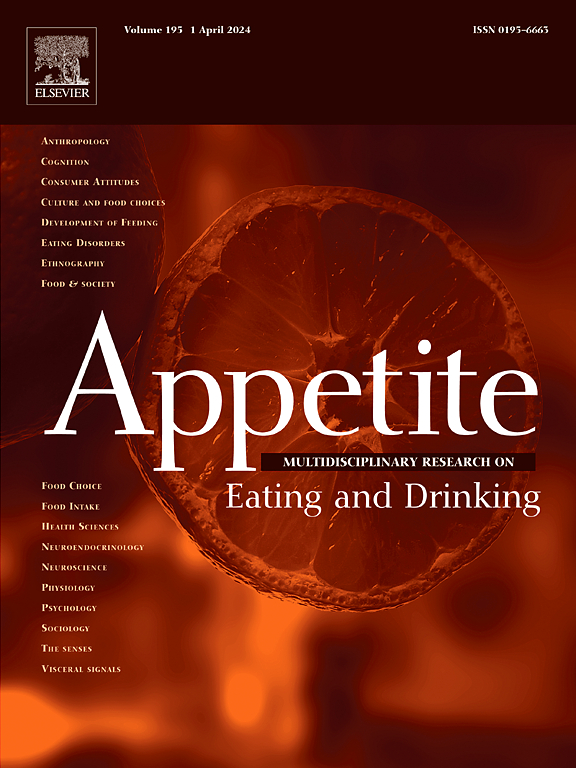Parental self-efficacy, parental restrictions and young children's food consumption: does socio-economic status play a role?
IF 3.8
2区 医学
Q1 BEHAVIORAL SCIENCES
引用次数: 0
Abstract
Compared with ample evidence on the influence of the home food environment on children's food consumption, associations between certain aspects of the social home food environment (such as parental self-efficacy (PSE) and parental restrictions) and young children's food consumption are less studied. Our aims were 1) to investigate the associations among feeding-related PSE, sugary food and drink (SFD)-related parental restrictions, and children's food consumption, and 2) to determine whether socio-economic factors (parental education level and household relative income) moderate them. We used cross-sectional data from 564 Finnish 3- to 6-year-olds participating in the DAGIS study. Parents completed a questionnaire assessing the home food environment and socio-economic status and a food frequency questionnaire assessing children's food consumption. Principal component analysis was used to identify SFD-related parental restriction patterns. We calculated a children's Healthy Food Intake Index (HFII) using food frequency data. We regressed the associations among feeding-related PSE and SFD-related parental restriction patterns in single and multiple regression models. Moderation by parental education level and household relative income was also tested. We identified three SFD-related parenting practice patterns: restricting SFD consumption, restricting SFD accessibility, and restricting SFD availability. Feeding-related PSE (B = 0.88, p < 0.001) and restricting SFD availability (B = 0.46, p < 0.001) were significantly associated with the children's HFII after adjusting the model for socio-economic factors. Parental education level or household relative income did not moderate any of these associations. Future health promotion interventions should target enhancing feeding-related PSE and restricting SFD availability to improve children's food consumption despite socio-economic status.
父母自我效能感、父母限制与幼儿食物消费:社会经济地位是否起作用?
与家庭食物环境对儿童食物消费影响的大量证据相比,社会家庭食物环境的某些方面(如父母自我效能感(PSE)和父母限制)与幼儿食物消费之间的关系研究较少。我们的目的是1)调查与喂养相关的PSE、与含糖食品和饮料(SFD)相关的父母限制与儿童食物消费之间的关系,以及2)确定社会经济因素(父母教育水平和家庭相对收入)是否会调节它们。我们使用了564名参与DAGIS研究的3- 6岁芬兰儿童的横断面数据。家长们完成了一份评估家庭食物环境和社会经济地位的问卷,以及一份评估儿童食物消费的食物频率问卷。主成分分析用于鉴定与sfd相关的亲本限制模式。我们使用食物频率数据计算儿童健康食物摄入指数(HFII)。我们在单回归模型和多回归模型中回归了与喂养相关的PSE和与sfd相关的亲代限制模式之间的关联。父母受教育程度和家庭相对收入的调节作用也被检验。我们确定了三种与SFD相关的养育模式:限制SFD消费、限制SFD可及性和限制SFD可用性。喂养相关PSE (B = 0.88, p <;0.001)和限制SFD可用性(B = 0.46, p <;0.001)与儿童的HFII显著相关。父母受教育程度或家庭相对收入对这些关联没有任何调节作用。未来的健康促进干预措施应以提高与喂养相关的PSE和限制SFD的可得性为目标,以改善儿童的食物消费,无论其社会经济地位如何。
本文章由计算机程序翻译,如有差异,请以英文原文为准。
求助全文
约1分钟内获得全文
求助全文
来源期刊

Appetite
医学-行为科学
CiteScore
9.10
自引率
11.10%
发文量
566
审稿时长
13.4 weeks
期刊介绍:
Appetite is an international research journal specializing in cultural, social, psychological, sensory and physiological influences on the selection and intake of foods and drinks. It covers normal and disordered eating and drinking and welcomes studies of both human and non-human animal behaviour toward food. Appetite publishes research reports, reviews and commentaries. Thematic special issues appear regularly. From time to time the journal carries abstracts from professional meetings. Submissions to Appetite are expected to be based primarily on observations directly related to the selection and intake of foods and drinks; papers that are primarily focused on topics such as nutrition or obesity will not be considered unless they specifically make a novel scientific contribution to the understanding of appetite in line with the journal's aims and scope.
 求助内容:
求助内容: 应助结果提醒方式:
应助结果提醒方式:


